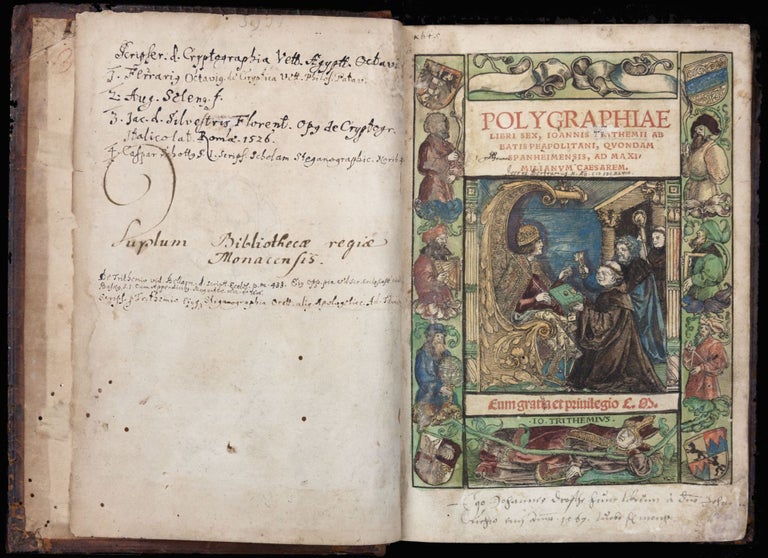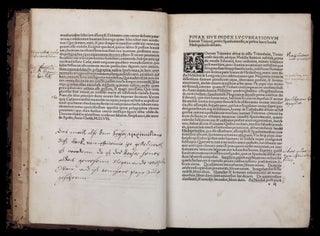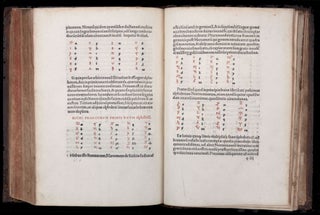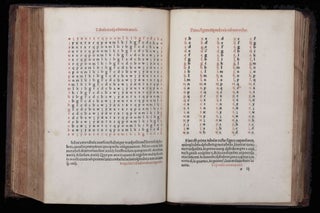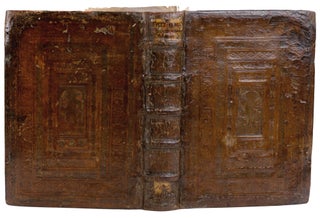Polygraphiae libri sex.
Small folio [26.0 x 17.9 cm], (270) ff. (here without blanks b6 and r6), two 5-block woodcut title pages in contemporary hand-color, the first of which with letterpress text printed in red, elsewhere several ciphers and headings printed in red and black, woodcut initials. Bound in near contemporary south German stamped calf dated 1587 on upper cover (see below), manuscript title label laid to spine, slots for straps, red edges, indexing tabs to fore edges, 18th-century (?) monastic book label inside upper cover (see below), modern book label inside lower cover. Rubbing, edge wear, and small restorations to spine and boards, remnants of gilding to tooling, minor worming. Early modern ownership inscriptions on front flyleaf and title page (see below), many early annotations in several hands (some of which lightly trimmed at fore edge), minor abrasions to first title page, mend to second title page, occasional minor marginal hand soiling and water staining, occasional minor staining and worming, the occasional minor marginal loss (r5) or tear (p4, 2B2). Rare first edition of this landmark of cryptography, “the first printed book on the subject” (Kahn), here in an example heavily annotated in several early modern hands, with its two woodcut title pages decorated in contemporary hand-color, and all preserved in a fine, stamped German binding dated 1587. The only work of Johannes Trithemius (1462-1516) on cryptography to enjoy contemporary publication, the Polygraphia significantly advanced cryptographic techniques, and it remains a cornerstone of the discipline today, not only in mathematics, but also in the humanities (e.g., in attempts to decipher the mysterious Voynich manuscript), in economics (cryptocurrency), and indeed in global politics (notes on Trithemius can be found among declassified NSA files: https://tinyurl.com/yxhyjeuo). In its time, however, the publication of the Polygraphia caused much concern about its shadowy commerce not with the Dark Web or rogue states, but with the demonic netherworld, magic and dangerous arcana: Trithemius’ Steganographia (c. 1499), which circulated in manuscript but was not printed until 1606 (at which time it went straight onto the Index librorum prohibitorum), had caused a stir by posing as a treatise about using spirits to communicate over long distances (it is, in fact, about cryptography). Introductory passages in the Polygraphia, therefore, were careful to emphasize the work’s own logical, mathematical bases as opposed to the mystical-magical, angelic-astrological reputation that preceded it in the Steganographia. The annotators of this volume also sedulously note mentions of the Steganographia, and these annotators are at pains to emphasize the orthodoxy and sound ingenuity of the Polygraphia. Annotators here are also especially attentive to the bibliographical reputation of Trithemius, who authored many works and augmented the monastic library of Sponheim by some 2000 volumes (both printed and manuscript) during his tenure as abbot, and to the complicated procedures of the ciphers he describes. The Polygraphia is composed of five books. Book I presents some 400 alphabets (minutiae) of 24 letters arranged in two columns, with each letter corresponding to a Latin part of speech (noun, verb, adjective, etc., some 9000 words in total), all of which can be interchanged to form coded pseudo-prayer sentences (known as the Ave-Maria Cipher). Book II contains more than 1100 alphabets arranged in three columns corresponding to more than 3000 invented words (e.g. “i” could be modol, aschor, vasmoi, etc.). Book III prints 132 invented alphabetic arrangements, from which the second letter of each word is to be removed to write coded messages. Book IV illustrates two canonical hash tables (80 alphabets and 98 alphabets), allowing vast permutations, and includes twelve planispheric wheels which each comprise six categories of 24 numbers combined with the 24 letters. Book V is a catalogue of ancient and invented alphabets (Ethiopian, alchemical, astrological, etc.) as well as invented alphabets such as the tetragramaticus and enagramaticus with examples given of their use. The volume concludes with the Clavis Polygraphiae, which has its own hand-colored woodcut title page and summarizes each of the preceding books. Trithemius is noted for his innovative use of multiple alphabetic systems to strengthen ciphers. “Polyalphabeticity took another step forward in 1518, with the appearance of the first printed book on cryptology, written by one of the most famous intellectuals of his day… It is book V that contains Trithemius’ contributions to polyalphabeticity. Here appears, for the first time in cryptology, the square table, or tableau … Trithemius’ system is also the first instance of a progressive key, in which all the available cipher alphabets are exhausted before any are repeated. Modern cipher machines very often embody such key progressions” (Kahn). The Polygraphia, as has been recently discovered (Ernst, 1996), in fact provides the necessary cryptographic keys to deciphering Book III of the Steganographia. Johannes Trithemius was forced to vacate the abbacy of Sponheim when rumors of witchcraft associated with his Steganographia prompted his monks to revolt. As Galland notes, the Polygraphia’s treatment of communication by unintelligible means was also seen by many as suspect: “The strange and bizarre terms and characters which [Trithemius] interspersed throughout the composition of the work soon caused him to be suspected of dealing in the black art … This suspicion continued all during the course of the 16th century.” Despite this dubious reputation, the present Polygraphia was dedicated to the Emperor Maxmilian, who had entertained Trithemius to his court – a scene depicted in the woodcut title vignette in which Trithemius presents the emperor with a padlocked book (an annotation in this copy also expands on the relationship between these two men and Pope Julius II). Trithemius’s use of both red and black printing throughout the book is crucial for properly reading ciphers. The volume’s elaborately stamped binding is south German, dated 1587 on its upper cover, and with remnants of gilding still present. At the center of the upper cover is Christ with a square halo standing atop an orb, giving the benediction with his right hand, holding an orb with cross in his left; on the lower cover is Christ with a nimbus, holding a cross in his right hand, shouldering a cross on his left side, treading on a serpent, and at the foot of image is the ‘VDMIE’ cipher (Verbum Domini manet in eternum) widely associated with Protestantism at the time (for its use in bindings, see M. J. Husing, pp. 190-3). Additional distinctive tools of putti and prophets would likely, with further research, lead to a firm identification of the binder. An inscription on the title page notes that a certain Johannes Dross (?) purchased the volume from a certain Johannes Cursius (?) for two florin coins in 1567. This hand is responsible for many of the annotations to the text. The name Justus Bertramus and date of 1648 is also on the title page; this is perhaps the ‘philologus’ Justus Bertramus who contributed to the 1658 Epistolae Medicinales à Doctis vel ad Doctos scriptae by Thomas Bartholin. A third name, Gruner, also appears on the title. A ‘duplum’ inscription (18th century?) of the Bib. regia Monacensis (Munich) is on the front flyleaf. Inside the upper cover is the 18th-century (?) engraved book label of the Theatine monastery of Saints Adelhardus and Caietanus in Munich. The book’s place of printing/publication is disputed, but consensus now seems to be that the work was printed chiefly by Michael Furter, Basel, who died between March 5 and May 2, 1517. See Benzing for information on Furter types employed. For documentary evidence, see K. Stehlin “Regesten zur Geschichte des Buchdrucks 1501-1520,” in Archiv für Geschichte des deutschen Buchhandels, v. 14 (1891), no. 2022 (Dec. 1, 1517) and no. 2065 (June 22, 1519). The place of printing and publication are given as Oppenheim by Panzer, Brunet, Grässe, Caillet, LC, and Shulman. The printer is given as A. Petri (Basel) by Isaac, Dodgson, BM STC and Wellcome. The colophon (p. [538]) reads “Impressum ductu Ioannis Haselberg de Aia bibliopoae ... M.D. XVIII, men. Iulio.” The five-part woodcuts on title pages are ascribed by Dodgson to Hans Springinklee and by M. Lankoronska (Gutenberg-Jahrbuch, 1955, p. 111) to an artist of Burgkmair’s workshop identified with the “Petrarcameister.” Signatures: a-b6, A8 B-Z6, 2a-2b6 c-m6 n8 o-r6, 2A6 2B-2C4. * Adams T-979; Panzer, VII, 491, 23; Brunet, V, 960; Grässe, VII, 204; Caillet, A.L. Sciences psychiques, III, 10848; Isaac, 14325; Dodgson, I, 376; BM STC German, 1455-1600, p. 871; Wellcome cat. of printed books, I, 6353, 6357; Benzing, J. Haselberg, 9; Shulman, D. Cryptography, p. 1; Galland 183; VD16 T1966; Kahn, pp. 130-6; E. Thomas “Schwarzweisse Magie: Der Schlissel zum dritten Buch der Steganographia des Trithemius,” Daphnis: Zeitschrift fer Mittlere Deutsche Literatur 25:1-205 (1996); N. Brann, Trithemius and Magical Theology: A Chapter in the Controversy over Occult Studies in Early Modern Europe; N. Brann, The Abbot Trithemius (1462-1516): The Renaissance of Monastic Humanism; M. J. Husing, “Zur Praxis un Psychologie der älteren Buchbinder, Zeitschrift für Bücherfreunde, vol. 1010, no.2 (1918/19), pp. 183-93; D. Kahn, The Codebreakers.
Sold

